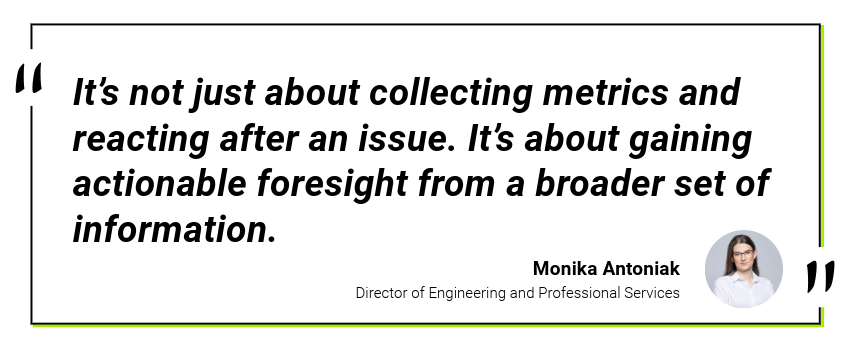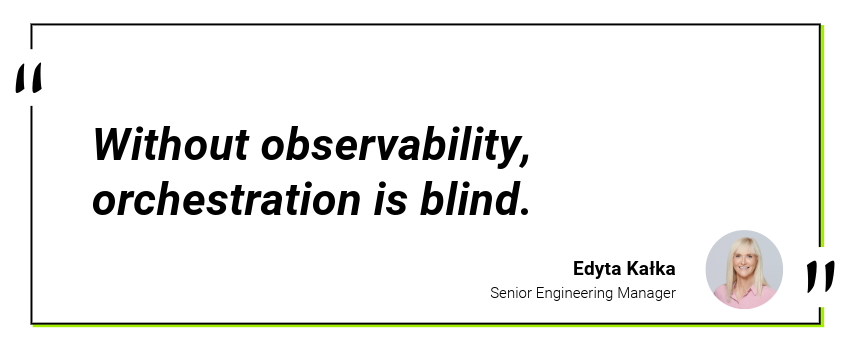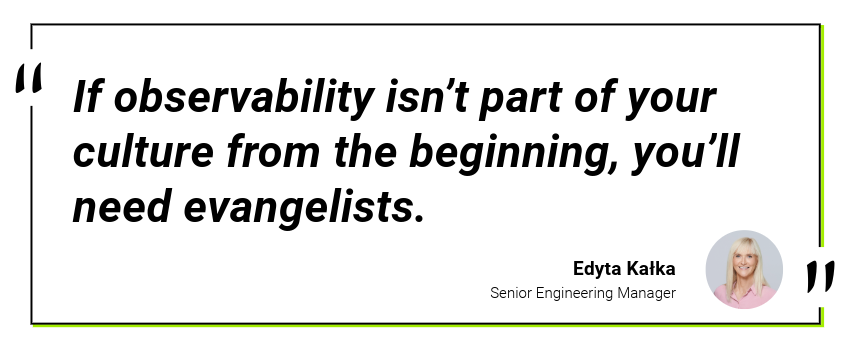To learn more about the increasing importance of telemetry in network management, we spoke with Edyta Kałka, Senior Engineering Manager, and Monika Antoniak, Director of Engineering and Professional Services at CodiLime. Drawing on their expertise in observability, automation, and operations, they shared why telemetry is no longer just about monitoring network health but is now about foresight, proactivness, and aligning tech with business priorities.
From Monitoring to Strategic Observability
Benjamin Wharton: Let’s start with the big picture. How should today’s network leaders think about telemetry? Is it still just about monitoring, or is it becoming something more strategic?
Edyta Kałka: I’d start by speaking more broadly about observability, not just telemetry. Right now, observability is the backbone of any modern system. You can't build anything reliable without understanding what’s happening inside it, which starts in the very early stages of development.
For example, if you're building ETL pipelines, and something isn't working, you need observability to check each stage. Was the data scraped correctly? Was it transformed properly? Are there issues with storage, like duplicates or performance problems? Without visibility into each step, you’re working blind.
Monika Antoniak: From an operational perspective, it’s also important to recognize how things have changed. Traditionally, we used basic monitoring tools like SNMP, which only offered limited metrics. You had a human reading that data, often after something had already gone wrong.
Telemetry changes that. It expands the data set, and more importantly, it allows you to transform that data on the fly. It’s not just about collecting metrics and reacting after an issue. It’s about gaining actionable foresight from a broader set of information.

The Business Value of Telemetry
Benjamin Wharton: That brings us nicely to the next question. Telemetry promises actionable insights, but from a business perspective, where does it deliver the most impact?
Edyta Kałka: First, you need to answer what matters most to your business. Is it uptime? Security? Latency? Once you know that, you can arrange your observability strategy around it. Some systems can tolerate a bit of downtime. Others can't afford even a minute without risking lawsuits or customer churn. So first of all, it depends on what is essential for you.
Monika Antoniak: Exactly. And it’s not just internal data. Your data sources don’t have to be limited only to the network. For example, during one of our webinars on AI , we showed how you can incorporate external data, like social events that may cause crowd behavior. If you can predict a spike in traffic due to a certain event, you may not be able to prevent the surge, but you can prepare and manage the impact.
Edyta Kałka: Exactly, and that’s where we’re heading; toward self-healing systems. At first, people used monitoring to check metrics manually. Then, as another advancement, we introduced baselines, thresholds, and aggregates, so even if we couldn’t quite interpret the data entirely, we could see that it differs from a week or a month ago. Now, with AI, we can predict failures. We can forecast when something might break with confidence and even propose a likely timeframe.
Once you reach that stage, it makes sense to react ahead of time. For example, if a certain service won’t last long under its current load, and it's from traffic that you don’t really care about from a business perspective, you can deprioritize it. But if it’s from your paid users, you scale up or protect it. Telemetry gives you the data to make these nuanced decisions, even automatically.
From Reactive to Proactive Operations
Benjamin Wharton: So it’s about identifying what’s most important, collecting data around it, and then acting before a problem happens.
Monika Antoniak: Or at the very least, being prepared to act. You may not know the exact scenario yet, but you’ll have the early warning signs and the data to respond effectively.
Benjamin Wharton: Like having warning lights before the issue even occurs.
Monika Antoniak: Exactly.
Benjamin Wharton: How far along are we in shifting from reactive operations to true predictive, AI-assisted optimization?
Monika Antoniak: We’re definitely moving in that direction. AI can process multiple data sources in parallel. A person can only analyze things sequentially. With AI, you get broader, faster insights.
Edyta Kałka: Picture a NOC or SOC full of big screens with dashboards and widgets. People stare at them for hours, waiting for something to go red. Now, imagine those dashboards are smarter. AI highlights what’s relevant, even if it hasn’t been a problem before, because it sees patterns we might miss. It can say, “Something odd is happening every 20 hours,” and raise a flag on the dashboard for you.
Monika Antoniak: That’s right, and it can spot things that haven’t been an issue before, or something rare that only comes along on very long cycles. The AI catches these things that a human would have difficulty seeing.
It doesn’t have to act on it, but it tells the operator to take a look. That’s a huge help.
The Role of Telemetry in Automation and Orchestration
Benjamin Wharton: You mentioned that it doesn’t have to act on the information, so where does telemetry fit into broader network automation and orchestration strategies? Should it be treated as a separate tool, or something more foundational?
Monika Antoniak: It used to be treated as a separate tool. Monitoring was standalone. But now, telemetry is foundational. It’s how automation and orchestration systems know what’s happening and what to do next.
Automation reacts to changes; telemetry can trigger scripts, for example. Orchestration is even more complex: it checks the entire environment before running workflows. Is it safe to deploy now? Will it cause disruption? Observability provides those answers.
Edyta Kałka: Without observability, orchestration is blind.

Enterprise-Scale Telemetry: Architectures and Tooling
Benjamin Wharton: What kinds of telemetry architectures or tooling actually work at enterprise scale? And how do you balance granularity with simplicity?
Edyta Kałka: That’s not easy, and it really depends on your architecture and environment. Are you cloud-native or on-premises? Monolithic or distributed? If you have microservices, then distributed tracing is critical. If you're running a monolith, that might not be necessary.
You also need to consider whether existing tools meet your needs. Sometimes they don't. If your setup is too complex or specific, it may make sense to build something custom. And you need to know what you’re measuring. Are raw metrics enough? Or do you need SLOs or KPIs to drive your decision-making?
Monika Antoniak: And always think in terms of platforms, not just tools. Tools are limited; platforms are expandable. If you're using something with OpenTelemetry support or plugin ecosystems, you can grow and adapt without starting from scratch.
Edyta Kałka: A big problem is when every team picks its own tools. We’ve seen companies with five or six systems that don’t talk to each other. It becomes impossible to get a unified view. But sometimes you can’t just throw those tools away; it’s too expensive! In that case, try to create a platform that aggregates or correlates them.
Monika Antoniak: Observability’s power is in correlation. If tools don’t talk to each other, you miss the bigger picture. It’s not about seeing one piece of the puzzle; it’s about seeing how the pieces fit together.
Changing the Culture of Observability
Benjamin Wharton: So an additional benefit of observability is it breaks down silos and unites teams around a shared platform.
Monika Antoniak: And people start seeing things from new angles, not just their own.
Edyta Kałka: But if observability isn’t part of your culture from the beginning, you’ll need evangelists. We’ve seen large companies create dedicated teams just to promote observability. These teams train others, show them what’s possible, and help build buy-in.

Monika Antoniak: It’s also about cross-functional collaboration. Network engineers need to talk to software engineers. Developers need to instrument their code with the right metrics. And everyone needs to understand what those metrics mean.
Common Pitfalls in Legacy and Multi-Vendor Environments
Benjamin Wharton: That leads to my final question. What are the biggest mistakes you’ve seen when implementing telemetry in legacy-heavy or multi-vendor environments?
Monika Antoniak: One big mistake is trying to bolt observability on after the fact. It should be baked into the system from the start. And if you’re dealing with legacy, don’t waste effort implementing into systems that are going away soon.
Edyta Kałka: Another big mistake is trying to observe everything. That becomes extremely expensive. Companies collect raw data with minimal aggregation and want to keep it all forever. Storage costs alone can cripple a budget.
Monika Antoniak: Prioritize. You don’t need every data point. Focus on what gives you insight.
Edyta Kałka: Think about frequency, too. Data you check every few minutes should be in fast storage. Data you check once a month? Store it in cold storage. Aggregate what you can. Don’t overspend on data you rarely use.
Monika Antoniak: And again, extendable platforms help! You don’t have to solve everything on day one. Build something you can grow.
Final Thoughts
Benjamin Wharton: That’s great advice. Anything you’d like to add for our readers?
Monika Antoniak: If you want to stay competitive, observability is a must. It lets you understand what’s happening, forecast what will happen, and act based on data.
Edyta Kałka: And stop thinking of it as monitoring. Observability is proactive. It’s your vision of the future. It’s what keeps you from getting that emergency call during your vacation.
Monika Antoniak: And if you’re just starting out, partner with someone who’s done it before. Learn from their mistakes, don’t do it alone.
Benjamin Wharton: Thank you both for helping our readers understand why telemetry is more important than ever. It’s been a real pleasure.
Edyta Kałka: Thank you.
Monika Antoniak: Thanks, Benjamin.









